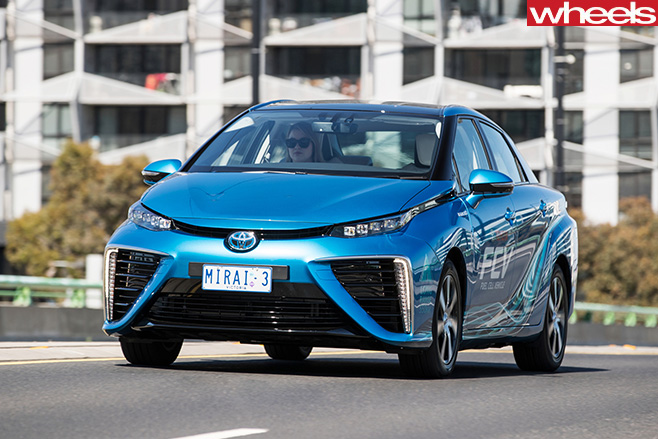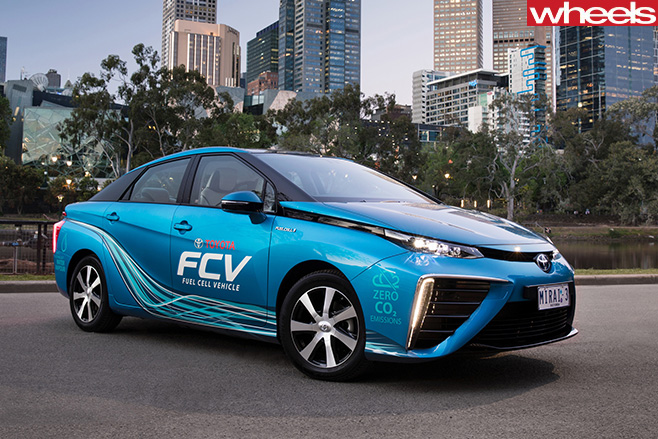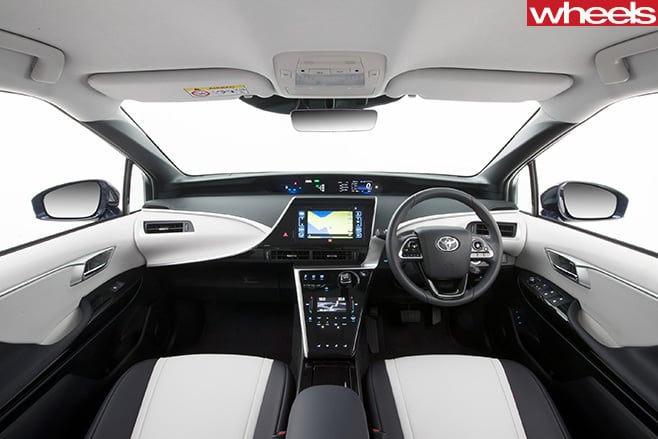LIKE an electric car but without the range anxiety, Toyota’s Mirai is one of the new breed of hydrogen fuel cell cars seen as crucial part of an emissions-free future.
WHAT IS IT? Toyota’s first mass produced hydrogen fuel cell car. The Mirai – a name that means “future” – is about the same size as a Prius. The fuel cell combines hydrogen and oxygen to create a chemical reaction that makes electricity, which is then used to power an electric motor, and water.
WHY WE’RE TESTING IT Toyota has imported three Mirais to Australia as part of a campaign to garner government and industry support for hydrogen vehicles. The company wants to convince key stakeholders to invest in hydrogen refuelling infrastructure, which would pave the way for cars such as the Mirai to be sold in Australia.

THE WHEELS VERDICT Surprisingly normal to drive, but it’s difficult to imagine anyone spending big money on a car such as this, especially with a rush of long range electric cars coming in the next few years. Hydrogen fuel cells seem to make sense for long-distance driving, but for most people a 500km electric car should do the trick.
PLUS: Can be refuelled like a regular car; 550km range from tank; decent performance; spacious interior MINUS: There’s currently nowhere in Australia to refuel it; the cost makes it seriously unappealing; electric cars will make more sense for most people

Similar to the Prius, its design is about slipping through the air cleanly (the co-efficient of drag is 0.29) and being as light as possible, although having specially designed 17-inch alloy wheels save 2kg seems superfluous when the Mirai weighs a podgy 1850kg. Blame that on the twin high-pressure hydrogen fuel tanks (one under the rear seat, the other behind the rear seat), the hydrogen fuel cell (which performs a chemical reaction to produce electricity) and the batteries borrowed from the Prius.
Yet as much as there’s tricky tech going on beneath the skin, the Mirai is otherwise about being normal. There are four seats, a steering wheel and pedals. And, with the exception of the very unfuturistic foot-operated park brake, there’s a modern flavour to the interior, from the touch buttons for the ventilation system to the Prius-inspired central instrument cluster and stubby gear selector.

Starting it is done with the press of a button, at which points things light up inside but no mechanical components come to life. Step on the throttle and response is immediate and generous. The 113kW of power is less relevant than the 335Nm, something that shifts the heavy body to 100km/h in 9.6 seconds.
The Toyota Mirai drives almost identically to an electric car, with near-instant throttle response. Performance is acceptable rather than exciting, and it’s accompanied by a subtle sound that’s like a cross between a whir and fast-paced clicking (it’s something to do with the hydrogen fuel cell).

Our brief drive wasn’t enough to explore the dynamic spectrum – it was an extended lap of the block near Toyota’s Sydney HQ – but it highlighted that the biggest smile you’ll get from the Mirai is because you’ve saved some dolphins or kept some flower petals plump, not because you’ve nailed an apex.
Overly light steering ensures it’s light-on for soul, while the brakes are responsive but with sponginess to the pedal.

So while the Mirai is still years away from being sold in Australia – if at all (it depends largely on refuelling infrastructure) – it’s difficult to see its circa-$80,000 price tag appealing to anyone other than those utterly devoted to the environmental cause. As Australia has proven in the past, almost none of us are.
SPECS Model: Toyota Mirai Engine: Electric motor powered by electricity from a hydrogen fuel cell Max power: 113kW Max torque: 335Nm Transmission: Single-speed auto Kerb weight: 1850kg 0-100km/h: 9.6sec (claimed) Price: $80,000-plus (estimated) On sale: No plans





